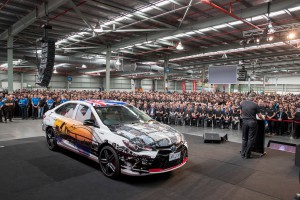Australia’s more than century-old auto industry effectively shuts down this month.
As thousands of workers watched, some with tears in their eyes, the last car rolled off the assembly line at Toyota’s plant in Melbourne on Tuesday. General Motors will wrap up production at its factory Adelaide later this month. Other manufacturers, including Ford, have already pulled out of the country.
Australia was once a significant manufacturing site for the industry, with products built there being shipped to markets as far away as the U.S. and Europe. But high costs and the government’s decision not to continue costly incentives, led the last automakers in Australia to pull out, a move that a report by the University of Adelaide has predicted will ultimately cost about 200,000 jobs.
“We haven’t seen in recent history the collapse of an entire industry, but that’s what is happening,” Professor John Spoehr, co-author of the University’s report, told the Associated Press.
(Ford the latest to abandon Australian auto manufacturing. For the story, Click Here.)
With a relatively small population spread over a vast continent, the automobile found early acceptance in Australia, and the first steam car was produced there in 1896. The first gas driven model. A Tarrant, was assembled in Melbourne in 1901.
Several foreign manufacturers, such as Ford, were early entrants into the Australian market, and the influx accelerated in the years after World War II.
Australian domestic production peaked around 1970, the year the collective industry output hit 475,000 vehicles. But production began to slip in the new millennium. It peaked at 388,985 in 20015, and by 2015 was down to 167,538. By then, there was already an exodus underway, manufacturers like Mitsubishi shuttering their operations due to high costs and opportunities to build in emerging markets such as Vietnam, Thailand, India and China.
Toyota, which produced its last Camry model in Melbourne on Tuesday, had been exporting about 70% of that plant’s output, much of it to the Mideast. Toyota came to the Land Down Under in 1963. That was the Japanese giant’s first assembly plant outside its own market, in fact. But production had steadily fallen from 2007, when it peaked at 149,000 vehicles.
A key sign of troubled came when Ford Motor Co. decided to end production in Australia, where it built its first vehicle, a Model T, in 1925. By mid-decade, Ford had already closed one of its two plants, and only 600 employees labored on at the Broadmeadows factory in Melbourne. That factory produced vehicles like the Falcon, perhaps best known outside of Australia for its role in the “Mad Max” film series. After a 91-year run, Ford closed Broadmeadows in October 2016.
With Toyota now closed, only Holden remains. The Melbourne-based brand began life in 1856 as a saddlery before entering the automotive market. It was acquired by General Motors in 1931. In recent years, it has produced a variety of GM products, including models designed by its Korean operations and one-time affiliates like Isuzu and Suzuki. And it briefly produced several high-performance models for the U.S.
(Click Here for more about Toyota ending production in Australia.)
But in late 2013, following a government decision to pull back on hefty incentives to manufacturers, GM said it would also pull out of the market, the last car set to roll down its Adelaide line on Oct. 20.
Some jobs will remain as manufacturers retain local sales and distribution operations to handle vehicles imported into Australia. Ford, for one, said it would retain a small base of designers and engineers to tweak foreign-made products for Australian tastes.
Nonetheless, the University of Adelaide study forecast the loss of up to 200,000 jobs directly on assembly lines or elsewhere in the country at supplier plants and at vendors serving factories like Ford’s Broadmeadows. The study also warned that Australia’s economy could lose almost US$23 billion from its GDP.
The failure to prop up local manufacturing has generated plenty of finger-pointing, including criticism of unions for driving up wages at a time when cheap labor was readily available to manufacturers in nearby Asian markets. For his part, current Prime Minister Malcolm Turnbull tried to deflect those who felt the
“People stopped buying the sedans being made in Australia,” said the PM, insisting the real problem was changing public taste. “The manufacturers who’ve progressively closed their operations in Australia have made it clear it’s not because of a failure of government subsidies.”
The government has had to kick in cash to help displaced workers, according to the AP which noted fully half of those let go by Ford have yet to find new jobs.
(To see how well auto sales tracked for September, Click Here.)
There are still a handful of manufacturers producing trucks in Australia, including Kenworth, a subsidiary of Paccar, and Italy’s Iveco. But on the automotive side, Australia’s assembly plants will soon go dark for the first time in more than a century.



“…It peaked at 388,985 in 20015, and by 2015 was down to 167,538…” Did it peak in 2001, 2005, or can you see in the future and the auto industry acme back to OZ in the 19000s ~ 20000s time frame?
Any event, we haven’t left OZ yet and doesn’t appear we will, at least for a long time. But then again, who can tell – it’s so volatile.